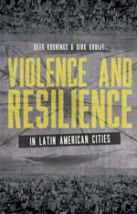Violence and Resilience in Latin American Cities

This book argues extensively that while there is no direct relation between poverty and systematic and organized violence, factors like persistent social exclusion, the opportunity to generate extra-legal income and power, and the absence and failure of government institutions lead to “new violence” in Latin American cities.
Conceptually, the authors are very careful in using the term “resilience” in relation to urban fragility. They interpret the processes that lead to fragility in a gradual way, where the institutionalization of social capital and alliances with the state are critical factors not only to cope with violence and insecurity, but also to mitigate it and eventually transform its underlying structures and causes.
Methodologically, the book draws on 23 city case studies with distinct features. Chapter 2 looks at the megacities Buenos Aires, Mexico City, Rio de Janeiro and São Paulo; Chapters 3 and 4 at the national capital cities Caracas and Bogotá; Chapters 5 and 6 at the medium-sized Central American cities of San Salvador and San José; and finally, Chapters 7 and 8 at two capitals of island nations, Kingston and Santo Domingo.
Analyses from the case studies challenge readers to overcome monolithic explanations of the relations between growing violence and urbanization in the context of Latin America, by revealing often seemingly contradictory results (for example, regarding the relation between violence and unemployment) and critically examining common notions (such as the culture of violence and crime history in Bogotá). They also highlight the many coping capacities and strategies that citizens have in their everyday lives, such as the practices of non-gang, ordinary youth in San Salvador. Several authors are also attentive to the relation between urban violence and international developments, like the illegal drug trade in Santo Domingo and how it manifests itself in problems in the city.
In sum, the diversity of case studies and the in-depth research of each of the authors reveal a multi-faceted image of Latin American cities, violence and insecurity, which calls for acknowledging the specific historical and local contexts. The latter is particularly necessary in order to address the structural factors that can reverse the trend of sustained and rising levels of crime and violence, drugs and organized crime that Latin American cities currently experience.
Book note prepared by Julia Wesely
Search the Book notes database
Our Book notes database contains details and summaries of all the publications included in Book notes since 1993 - with details on how to obtain/download.
Use the search form above, or visit the Book notes landing page for more options and latest content.
For a searchable database for papers in Environment and Urbanization, go to http://eau.sagepub.com/

